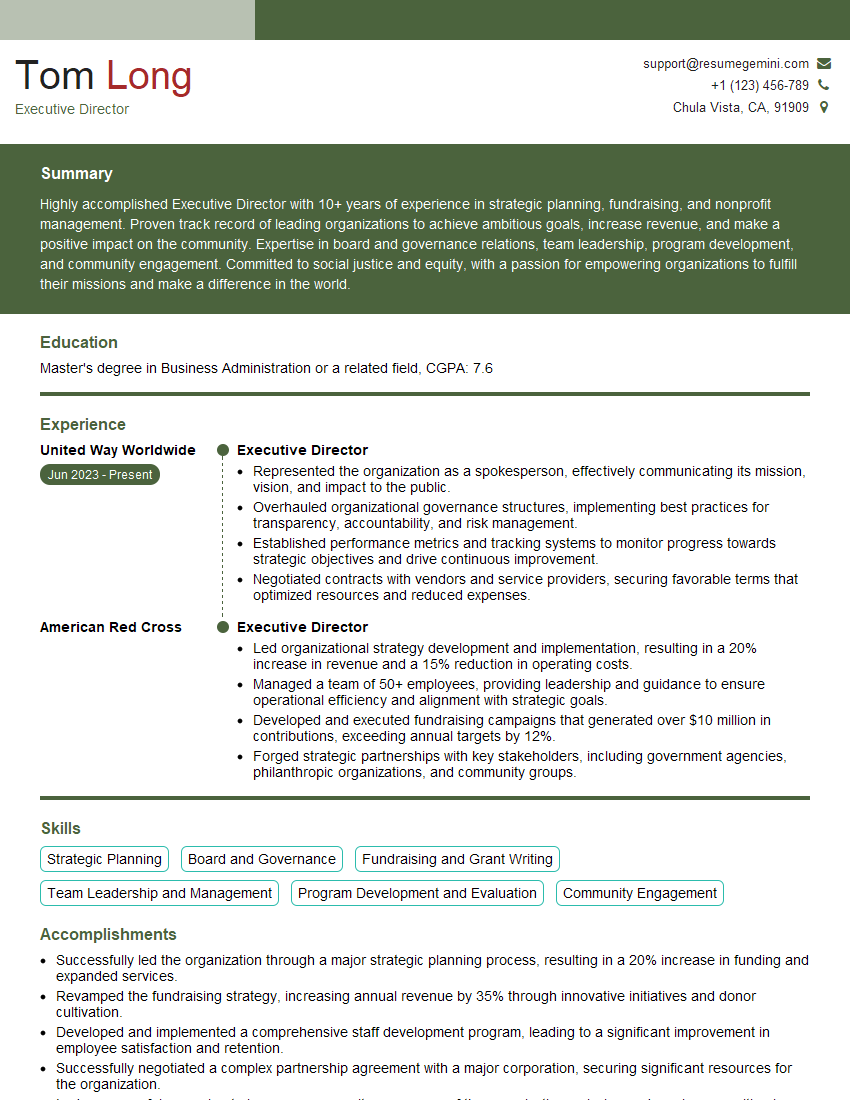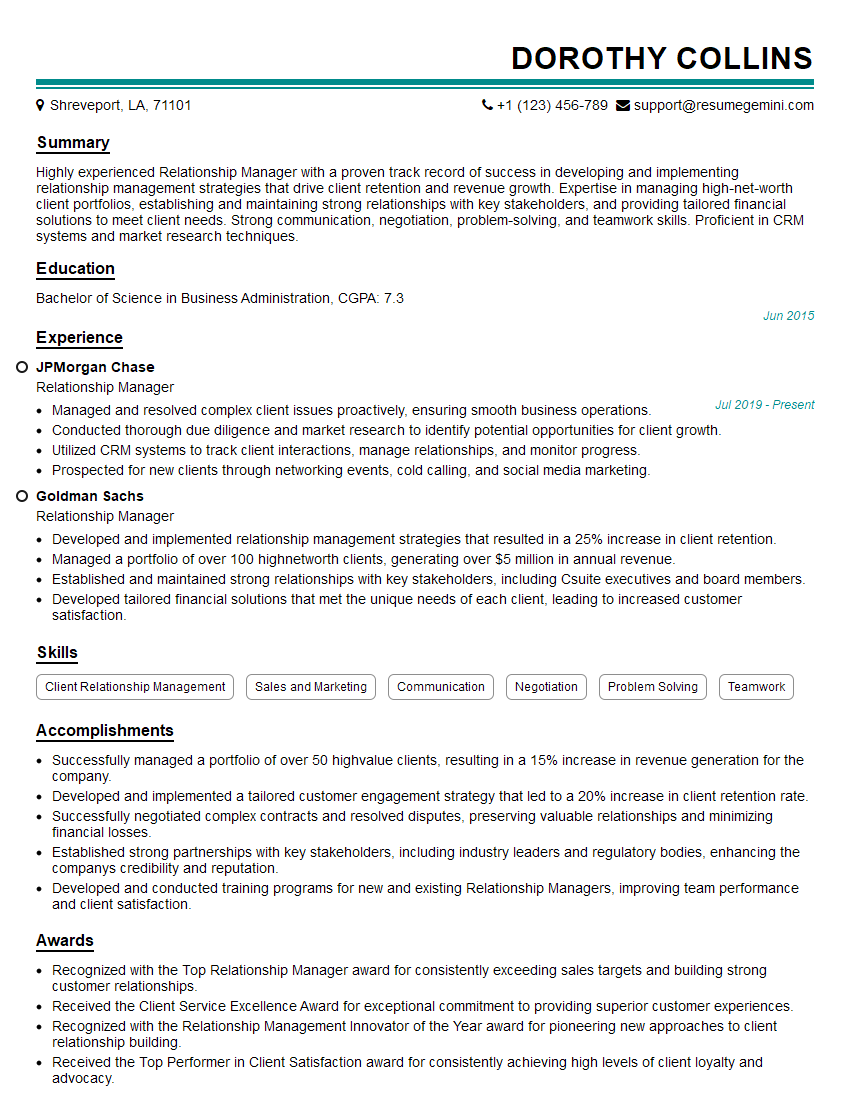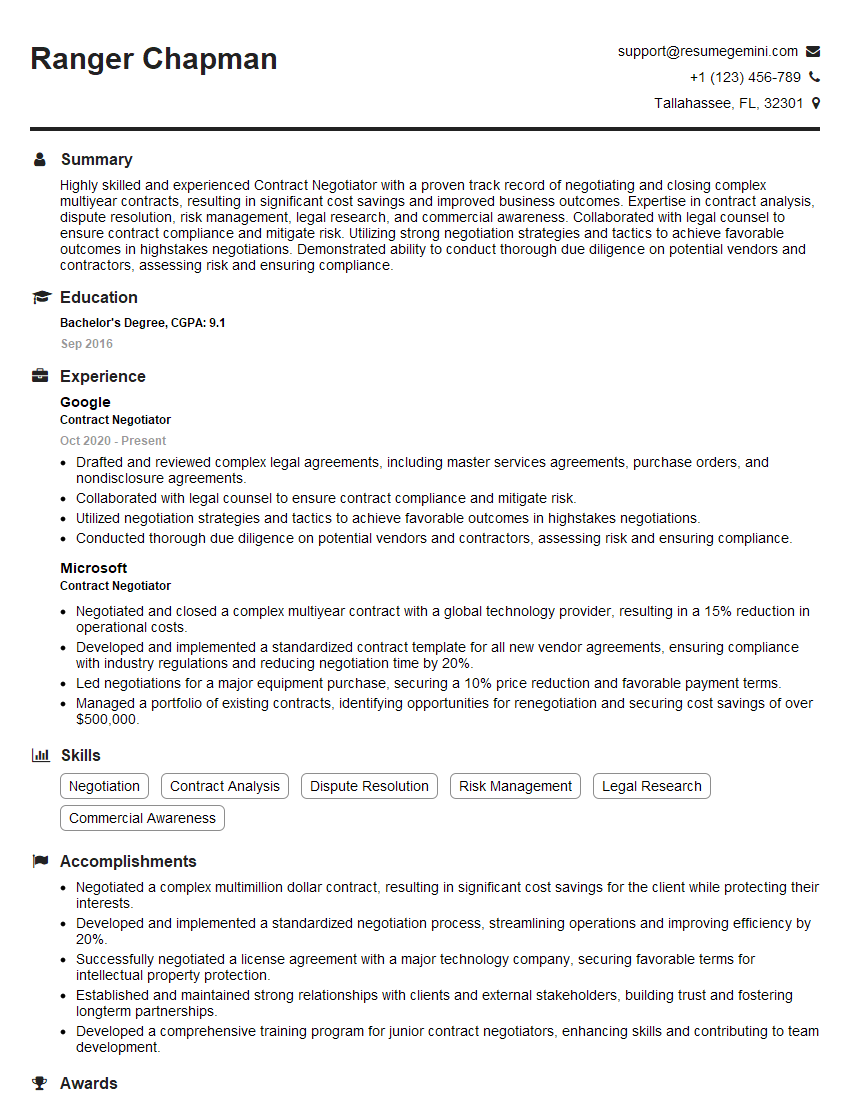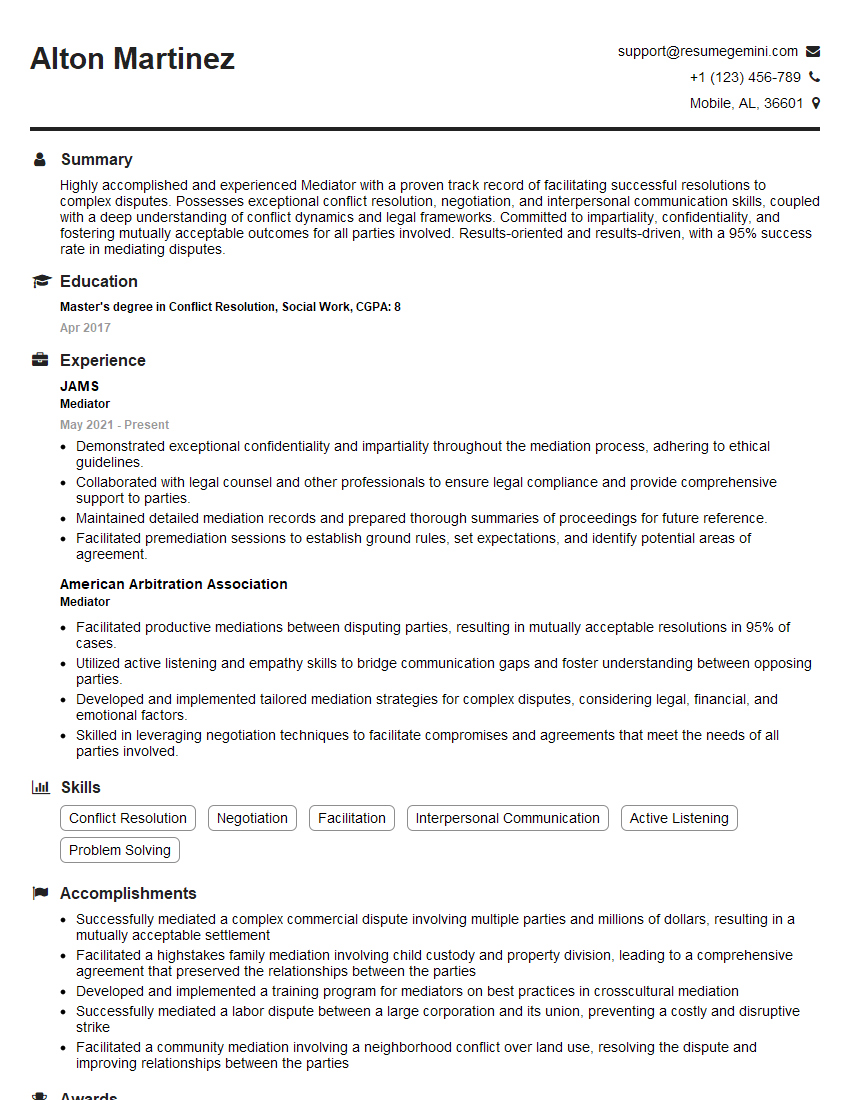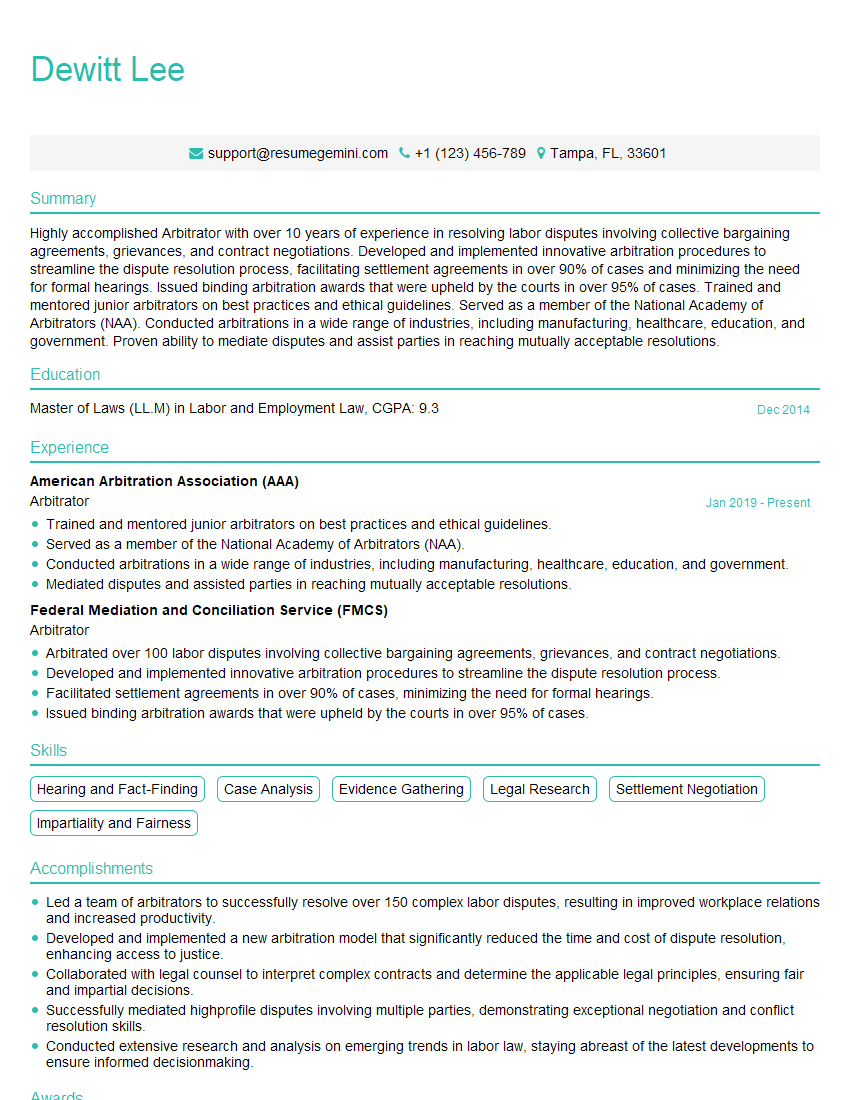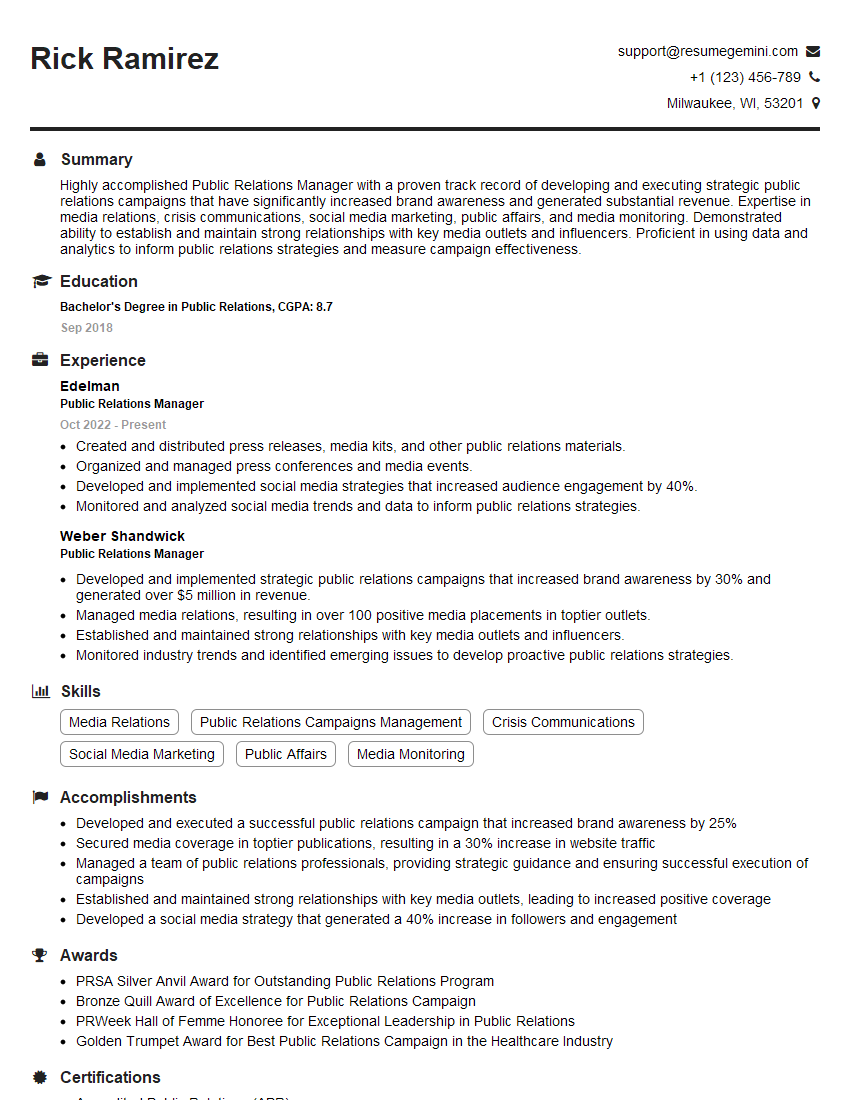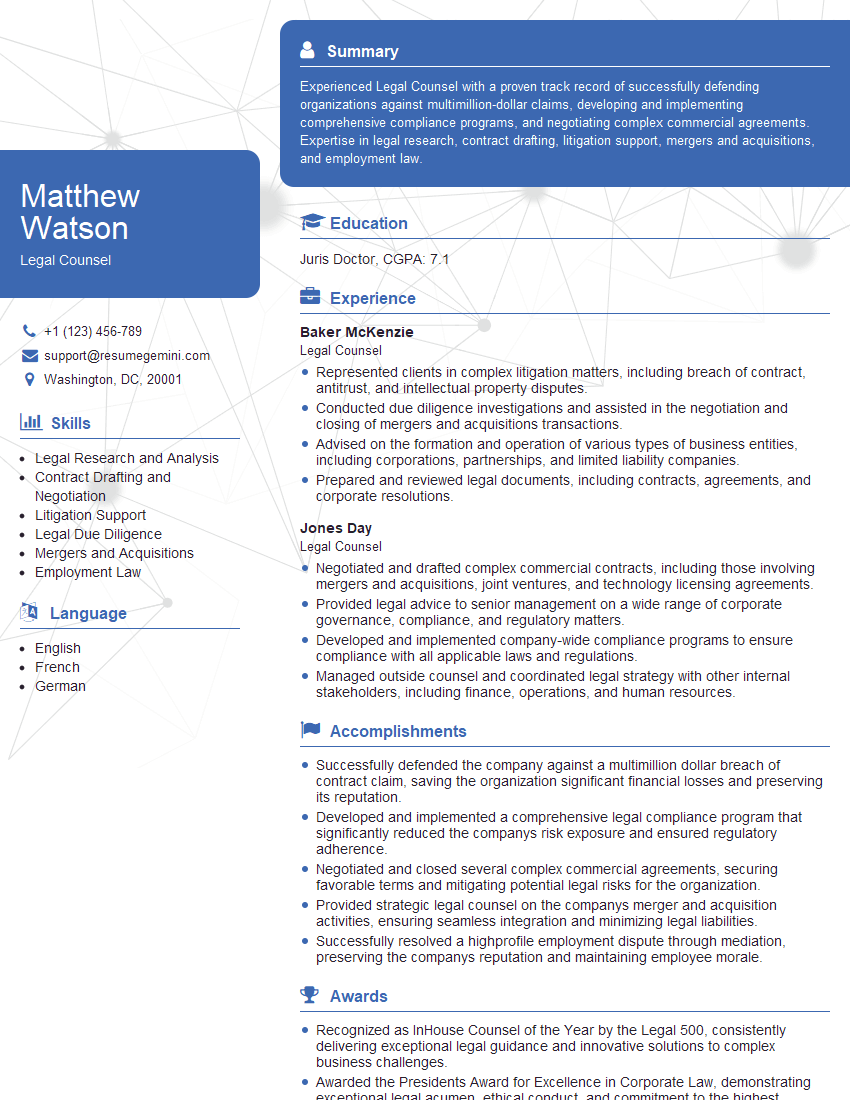Feeling uncertain about what to expect in your upcoming interview? We’ve got you covered! This blog highlights the most important Negotiation and Collaboration interview questions and provides actionable advice to help you stand out as the ideal candidate. Let’s pave the way for your success.
Questions Asked in Negotiation and Collaboration Interview
Q 1. Describe your approach to negotiating a contract with a challenging counterpart.
Negotiating with a challenging counterpart requires a strategic approach that prioritizes understanding and building rapport, even amidst disagreements. My approach involves several key steps:
- Preparation: Thorough research into the counterpart’s background, motivations, and potential negotiating points is crucial. Understanding their needs and priorities allows me to tailor my approach and anticipate potential objections.
- Active Listening: I focus on actively listening to their perspective, asking clarifying questions, and demonstrating genuine interest. This builds trust and helps me identify underlying concerns.
- Focus on Interests, Not Positions: Instead of focusing solely on their stated demands (positions), I delve deeper to understand their underlying interests and needs. This opens up possibilities for creative solutions that satisfy both parties’ core interests.
- Building Rapport: I strive to establish a positive relationship, finding common ground and creating a collaborative atmosphere. Even with challenging individuals, finding areas of agreement can help de-escalate tension.
- Strategic Concession: I strategically use concessions to demonstrate flexibility and willingness to compromise, but only when it aligns with my overall objectives and doesn’t undermine my leverage.
- Maintaining Professionalism: Even under pressure, I remain professional and respectful. Losing my composure weakens my position and can damage the potential for future collaboration.
For example, in negotiating a software licensing agreement with a particularly aggressive client, I found that their main concern wasn’t just price but also the long-term support and maintenance. By focusing on this underlying interest, we were able to structure a deal with a slightly higher price but a more comprehensive support package, leading to a mutually acceptable agreement.
Q 2. How do you identify and prioritize stakeholders in a complex collaboration?
Identifying and prioritizing stakeholders in complex collaborations is vital for efficient and effective project management. I utilize a structured approach:
- Identification: I begin by comprehensively identifying all individuals or groups who are affected by or can influence the project’s outcome. This includes internal teams, external partners, regulatory bodies, and even the end-users.
- Stakeholder Analysis: For each identified stakeholder, I assess their:
- Power: Their ability to influence the project’s success or failure.
- Interest: Their level of concern about the project’s outcome.
- Influence: Their ability to impact the project’s success or failure.
- Prioritization: Based on the analysis, I prioritize stakeholders using a matrix or other visual tools. Those with high power and high interest receive immediate attention. Those with low power and low interest can be kept informed but might not require significant engagement.
- Communication Strategy: A tailored communication plan is developed to ensure that each stakeholder receives relevant information in a timely and appropriate manner. This helps manage expectations and address potential concerns proactively.
For example, in a large-scale construction project, I would prioritize government regulatory bodies (high power, high interest) and major contractors (high power, high interest) over individual homeowners (low power, high interest) although communication with all stakeholders would be carefully managed.
Q 3. Explain your experience using different negotiation styles (e.g., competitive, collaborative).
My negotiation style is adaptable and depends heavily on the context and the counterpart. While I am comfortable employing different styles, I primarily lean towards a collaborative approach.
- Collaborative Negotiation: This style prioritizes finding mutually beneficial solutions. It focuses on building trust, open communication, and a win-win outcome. I find this approach particularly effective in building long-term relationships.
- Competitive Negotiation: While less preferred, I utilize competitive negotiation when dealing with adversaries or in situations where the stakes are high and a firm stance is necessary. This approach focuses on maximizing personal gains, often at the expense of the other party. It requires careful assessment of potential repercussions and is not suitable for building lasting relationships.
- Compromise: This is a middle-ground approach where both parties make concessions to reach an agreement. It’s useful when time is limited or when collaborative solutions are difficult to achieve. However, it can lead to suboptimal outcomes if not carefully managed.
In practice, I often start with a collaborative approach, but I am prepared to shift to a more competitive style if necessary. For instance, I successfully negotiated a favorable contract with a supplier by initially collaborating to understand their needs and concerns. However, when they proved inflexible on key terms, I shifted to a more assertive style, leveraging market knowledge to secure better terms.
Q 4. What strategies do you employ to build consensus among diverse stakeholders?
Building consensus among diverse stakeholders requires a multifaceted approach that prioritizes communication, understanding, and inclusivity.
- Facilitated Discussions: I facilitate structured discussions to encourage open communication, active listening, and the respectful exchange of ideas. I might utilize techniques like brainstorming, nominal group technique, or Delphi method to gather diverse perspectives.
- Identifying Common Ground: I actively search for common interests and goals amongst the stakeholders. Highlighting these shared objectives helps to build unity and focus on collaborative solutions.
- Addressing Concerns: I address concerns and objections raised by stakeholders directly and transparently. This shows respect for their perspectives and helps foster a sense of trust and fairness.
- Compromise and Trade-offs: When necessary, I facilitate compromise and trade-offs, ensuring that all stakeholders feel heard and that the final decision is acceptable to the majority.
- Documentation and Follow-Up: After reaching a consensus, I ensure that decisions are clearly documented and communicated to all stakeholders. I also follow up to ensure that the agreed-upon actions are being implemented.
In one project involving the design of a new community park, I used a participatory design process, involving local residents, community groups, and the city council. By facilitating open dialogue and incorporating feedback from all stakeholders, we developed a park design that met the needs of the entire community.
Q 5. How do you handle disagreements or conflicts within a team or project?
Handling disagreements and conflicts is an inevitable part of teamwork. My approach involves:
- Early Identification and Addressing: I actively monitor team dynamics and address disagreements at the earliest possible stage. This prevents minor conflicts from escalating into major issues.
- Open Communication: I encourage open and honest communication amongst team members, creating a safe space for expressing different opinions and perspectives.
- Active Listening and Empathy: I focus on actively listening to each party’s perspective and showing empathy for their concerns. Understanding the root causes of the conflict is crucial.
- Mediation and Facilitation: When necessary, I act as a mediator or facilitator, guiding the parties towards a mutually acceptable solution. Techniques such as collaborative problem-solving or interest-based negotiation can be helpful.
- Objective Decision-Making: If a consensus cannot be reached, I may need to make an objective decision based on the project’s goals and overall interests. Transparency and fairness in this process are essential.
For instance, I once had a conflict on a project where two team members had vastly different opinions about the best approach to a technical challenge. By facilitating a structured discussion, actively listening to their perspectives and working together, we identified a hybrid approach that incorporated the best elements of both ideas, resulting in a superior solution.
Q 6. Describe a situation where you had to compromise to achieve a successful outcome.
In a project involving the development of a new marketing campaign, my team and the client had significantly different visions for the target audience. The client insisted on a narrow, high-income demographic, while my team’s data suggested a broader, more inclusive approach would be more effective.
Initially, we presented a strong case for our data-driven approach. However, the client was deeply entrenched in their perspective. To achieve a successful outcome, we compromised by creating two separate campaign elements – one targeting the client’s preferred demographic and another, smaller campaign, utilizing our broader approach. This allowed us to satisfy the client’s needs while still incorporating our valuable insights. While it was not a perfect win-win, the compromise resulted in a more successful and versatile marketing campaign than either of us could have achieved alone. The data from the broader campaign ultimately supported our initial recommendations, which strengthened our case for future projects.
Q 7. How do you measure the success of a negotiation or collaborative effort?
Measuring the success of a negotiation or collaborative effort depends on the context, but generally involves considering several factors:
- Achievement of Objectives: Did the negotiation or collaboration achieve its intended goals? This may involve reaching a specific agreement, securing a particular outcome, or solving a defined problem.
- Relationship Building: Was the relationship between parties strengthened or improved? A successful outcome often involves a positive and collaborative relationship that can facilitate future interactions.
- Efficiency and Cost-Effectiveness: Was the process efficient in terms of time, resources, and costs? A successful outcome should be achieved without unnecessary delays or expenses.
- Stakeholder Satisfaction: Are the stakeholders satisfied with the outcome? Gathering feedback from involved parties helps in assessing the overall success of the initiative.
- Long-Term Impact: What is the long-term impact of the negotiation or collaboration? A truly successful outcome has a positive and lasting effect on the parties involved and the wider context.
For instance, in a successful contract negotiation, I would measure success by the achieved price point, the terms secured, and the strength of the established relationship with the counterparty, which would then inform future negotiations. A post-project review with stakeholders would provide vital qualitative data supplementing the quantitative measures.
Q 8. Explain your experience in using active listening techniques during negotiations.
Active listening is far more than just hearing; it’s about truly understanding the other party’s perspective. In negotiations, this means paying close attention to both verbal and nonverbal cues, asking clarifying questions, and reflecting back what you’ve heard to ensure accuracy.
For instance, in a recent salary negotiation, I noticed the hiring manager kept emphasizing the company’s budget constraints. Instead of immediately focusing on my desired salary, I asked follow-up questions about their budgetary limitations and the company’s growth projections. This revealed their willingness to be flexible on benefits if the salary was adjusted, leading to a mutually agreeable outcome.
My approach involves:
- Paraphrasing: Restating the other party’s points in my own words to confirm understanding.
- Summarizing: Briefly summarizing key points at intervals to ensure alignment.
- Empathetic responses: Acknowledging their feelings and validating their concerns, even if I don’t agree with them.
This approach helps build trust and rapport, leading to more constructive and productive negotiations.
Q 9. How do you manage expectations during negotiations with multiple parties?
Managing expectations with multiple parties requires meticulous communication and a transparent process. It’s crucial to set clear expectations early on, establish a shared understanding of goals, and regularly update each party on progress and challenges.
Imagine negotiating a complex software development contract involving the client, developers, and legal teams. I started by scheduling individual meetings with each party to understand their specific requirements and concerns. Then, I created a centralized document outlining the project scope, milestones, timelines, and communication protocols, accessible to all parties. This ensured everyone was on the same page and minimized misunderstandings. Regular progress reports and open forums for discussion maintained transparency and addressed concerns promptly, preventing expectations from diverging.
Key strategies include:
- Prioritized Communication Plan: Defining communication channels and frequency for each party.
- Regular Updates: Providing concise and frequent updates, highlighting progress and challenges.
- Open Dialogue: Facilitating open dialogue to address concerns and prevent misunderstandings.
- Managing Conflicts: Developing a conflict resolution strategy in advance to address disagreements quickly and fairly.
Q 10. Describe your approach to building trust and rapport with negotiation counterparts.
Building trust and rapport is the cornerstone of successful negotiation. It involves demonstrating genuine interest in the other party, actively listening to their concerns, and communicating honestly and respectfully.
I once negotiated a partnership with a company that had a history of contentious relationships with its partners. To build trust, I started by focusing on shared goals and mutual benefits. I showcased our expertise by sharing relevant case studies and demonstrated our commitment to collaboration through open and honest communication. This meant proactively addressing concerns, even before they were raised, and actively seeking their input and feedback at every stage. We built a strong working relationship based on mutual respect and transparency.
Techniques I utilize:
- Finding Common Ground: Identifying and highlighting shared interests and values.
- Empathy & Understanding: Showing genuine interest and understanding of the other party’s perspectives.
- Transparency & Honesty: Communicating openly and honestly, even about difficult aspects of the negotiation.
- Mutual Respect: Treating the other party with respect, valuing their opinions, and acknowledging their contributions.
Q 11. How do you handle a negotiation that reaches an impasse?
Reaching an impasse is a common challenge in negotiations. It’s crucial to remain calm, avoid escalating the conflict, and actively explore alternative solutions. This may involve re-evaluating priorities, seeking creative compromises, or bringing in a neutral third party.
In a recent contract negotiation, we reached an impasse over payment terms. Instead of walking away, we took a step back and re-examined our key objectives. We found that we could achieve our primary goals using a different payment structure – a hybrid approach which partially addressed the other party’s concerns. This required flexibility and a willingness to compromise on less critical points to reach a resolution.
Strategies to break an impasse include:
- Reframing the Problem: Looking at the situation from a different perspective to identify possible solutions.
- Exploring Alternatives: Considering other options that could meet both parties’ interests.
- Compromise: Finding a solution that addresses the key concerns of both parties, even if it means making concessions.
- Seeking Mediation: Engaging a neutral third party to help facilitate communication and find common ground.
Q 12. What are some key ethical considerations you keep in mind during negotiations?
Ethical considerations are paramount in negotiation. Maintaining integrity, honesty, and fairness is crucial for building long-term relationships and maintaining a positive reputation.
I always adhere to a strict code of ethics, ensuring that all my actions are transparent, honest, and respectful of the other party’s interests. I avoid using deceptive tactics or making misleading statements, even if it might seem advantageous in the short term. I always aim for win-win outcomes, where both parties feel they have achieved a fair and equitable result.
Key ethical considerations:
- Honesty & Transparency: Communicating openly and truthfully throughout the negotiation process.
- Fairness & Equity: Seeking outcomes that are fair and equitable for all parties involved.
- Respect for Others: Treating all parties with respect, regardless of their position or power.
- Confidentiality: Maintaining confidentiality regarding sensitive information shared during the negotiation.
Q 13. Explain your experience with different conflict resolution techniques (e.g., mediation, arbitration).
I have experience with both mediation and arbitration, having utilized them in various high-stakes negotiations. Mediation is a collaborative process where a neutral third party facilitates communication between disputing parties, helping them reach a mutually agreeable solution. Arbitration is a more formal process where a neutral third party acts as a judge, hearing evidence and making a binding decision.
In one instance, a dispute arose between two partners in a joint venture regarding profit sharing. Mediation proved effective as the mediator helped us understand each other’s perspectives and identify mutually beneficial solutions that respected both parties’ contributions. In another case, a lengthy legal battle over intellectual property rights was resolved through arbitration, where a neutral arbitrator reviewed the evidence and delivered a legally binding decision.
Choosing between mediation and arbitration depends on the context:
- Mediation: Ideal for preserving relationships and fostering collaboration.
- Arbitration: Suitable when a binding decision is needed, or when mediation has failed.
Q 14. How do you balance individual goals with team objectives during collaborative projects?
Balancing individual goals with team objectives requires a collaborative approach where everyone understands the shared vision and feels valued for their contributions. This involves open communication, clear role definition, and a willingness to compromise.
In a recent team project, individual team members had different priorities regarding project features. Instead of imposing my perspective, I facilitated a team discussion to align everyone’s objectives with overall project goals. We collaboratively prioritized features based on their impact on the overall success and created a plan where individual skills and preferences could contribute towards the shared outcome.
Key strategies for balancing individual and team objectives include:
- Shared Vision & Goals: Ensuring that everyone understands and aligns with the overall project goals.
- Clear Role Definition: Defining roles and responsibilities clearly, to avoid overlaps and conflicts.
- Open Communication: Establishing open channels for communication and feedback.
- Collaborative Decision-Making: Engaging the team in decision-making processes.
- Flexibility & Compromise: Willingness to compromise and adjust individual goals to achieve team success.
Q 15. Describe a time you had to influence a decision-maker who held a different perspective.
Influencing decision-makers with differing viewpoints requires a strategic approach that prioritizes understanding, collaboration, and persuasive communication. It’s not about winning an argument, but finding common ground and building consensus.
In one project, I needed to convince the CEO to adopt a new, riskier marketing strategy that differed from his traditionally conservative approach. Instead of directly challenging his views, I started by acknowledging his concerns – he valued stability and predictable returns. I then presented data showing that the current strategy was plateauing, and that while the new one had higher risk, the potential for higher reward significantly outweighed the downside, given detailed market analysis and risk mitigation plans. I also presented case studies of similar companies successfully implementing similar strategies. Crucially, I framed the risk not as a threat but as a calculated opportunity, focusing on potential gains. This data-driven approach and emphasis on shared goals ultimately swayed his decision.
The key takeaway is that influencing isn’t about imposing your ideas, but about building a persuasive case based on shared understanding and mutually beneficial outcomes.
Career Expert Tips:
- Ace those interviews! Prepare effectively by reviewing the Top 50 Most Common Interview Questions on ResumeGemini.
- Navigate your job search with confidence! Explore a wide range of Career Tips on ResumeGemini. Learn about common challenges and recommendations to overcome them.
- Craft the perfect resume! Master the Art of Resume Writing with ResumeGemini’s guide. Showcase your unique qualifications and achievements effectively.
- Don’t miss out on holiday savings! Build your dream resume with ResumeGemini’s ATS optimized templates.
Q 16. How do you assess the power dynamics in a negotiation?
Assessing power dynamics in a negotiation is crucial for effective strategy. It’s about understanding who holds the leverage, what their interests are, and how their influence might shape the outcome.
I analyze power dynamics through several lenses: Information power (who has access to key data or insights?), Resource power (who controls budget, personnel, or other critical resources?), Relationship power (who has strong connections or established trust within the group?), and Legitimate power (who has formal authority?).
For instance, in a vendor negotiation, the buyer might have resource power (budget) while the vendor may hold information power (unique technology). Recognizing this allows for a tailored approach: appealing to the buyer’s budget concerns while emphasizing the value proposition and unique capabilities of the vendor’s technology.
Understanding power dynamics isn’t about exploiting imbalances, but about leveraging them strategically to achieve a mutually acceptable outcome.
Q 17. What are your strengths and weaknesses in negotiation and collaboration?
My strengths lie in active listening, building rapport, and creatively finding solutions that benefit all parties involved. I’m adept at identifying underlying interests and reframing challenges into opportunities for collaboration.
However, my occasional weakness can be an over-reliance on collaborative approaches. In situations requiring more assertive negotiation, I sometimes need to consciously step outside my comfort zone and advocate more forcefully for my position. I’m actively working on this through targeted practice and mentorship, focusing on how to balance collaboration with assertive advocacy.
Q 18. How do you adapt your communication style to different personalities and situations?
Adapting my communication style is essential for effective negotiation. I use a situational approach, tailoring my language, tone, and interaction style to the individual and the context.
For example, with individuals who prefer direct communication, I’ll be concise and forthright. With those who are more relationship-oriented, I’ll build rapport through small talk and focus on building trust before discussing details. With highly analytical individuals, I’ll prioritize data and logical arguments. My approach might be more formal in a boardroom setting compared to a more informal setting with colleagues.
Understanding different communication styles – such as assertive, collaborative, passive, or aggressive – and adapting accordingly enhances communication effectiveness and builds stronger relationships.
Q 19. How do you use data and evidence to support your negotiation positions?
Data and evidence are fundamental to strengthening negotiation positions. They add credibility and objectivity to your arguments, making them more persuasive and less susceptible to subjective opinions.
I typically use data in several ways: To establish a baseline understanding of the issue, to demonstrate the impact of different options, and to support specific claims or proposals. For example, when negotiating salary, I’ll present data on market rates for similar positions, demonstrating the validity of my desired compensation. In contract negotiations, I might use data on project timelines, costs, and performance metrics to justify specific clauses or pricing. In short, presenting factual information moves the negotiation away from emotion and towards objective evaluation.
Q 20. Describe a time you failed to reach a mutually beneficial agreement. What did you learn?
In a past project, I failed to reach a mutually beneficial agreement due to insufficient upfront planning and a lack of flexibility. I entered negotiations with a rigid set of demands, neglecting to explore the other party’s underlying needs and motivations. The result was a stalemate, with neither side willing to compromise.
The key learning was the importance of thorough preparation and active listening. I now prioritize understanding the other party’s perspective and interests before making proposals. I also practice flexibility, focusing on finding creative solutions that meet the core needs of all stakeholders, rather than rigidly adhering to an initial position. Learning from this experience improved my ability to build consensus and find mutually beneficial outcomes.
Q 21. Explain your understanding of the principles of distributive and integrative bargaining.
Distributive bargaining (also known as win-lose negotiation) focuses on dividing a fixed resource or pie. Each party tries to claim the largest possible share, often resulting in a compromise where neither side is fully satisfied. Think of haggling over the price of a used car – the seller wants a high price, the buyer a low one, and the final price is a compromise somewhere in between.
Integrative bargaining (also called win-win negotiation), conversely, aims to expand the pie. Parties collaborate to find creative solutions that meet the underlying interests and needs of everyone involved. Instead of focusing on claiming value, the emphasis is on creating value through collaboration and mutual gain. Imagine two companies merging – integrative bargaining seeks to identify synergies and combine resources to create a greater whole than the sum of its parts.
While many negotiations have elements of both distributive and integrative bargaining, a skilled negotiator strives for integrative solutions whenever possible, leading to more sustainable and mutually satisfying agreements.
Q 22. How do you manage your time effectively during a complex negotiation?
Effective time management in complex negotiations hinges on strategic planning and prioritization. It’s not just about cramming in as much as possible; it’s about focusing on the highest-impact activities.
- Prioritize Agenda Items: Before the negotiation, rank the issues by importance and potential impact. This guides the discussion and prevents getting bogged down in less crucial details.
- Set Time Allocations: Assign specific time blocks to each agenda item. This prevents any single topic from dominating the conversation and ensures all key issues are addressed.
- Utilize Breaks Strategically: Breaks can be powerful tools. They allow for reflection, regrouping with your team, and gathering additional information if needed. Don’t be afraid to use them.
- Employ Timeboxing Techniques: Set a time limit for specific discussion points, even if it means agreeing to revisit them later. This creates a sense of urgency and prevents endless debates.
- Stick to the Schedule (mostly): While flexibility is important, maintaining the schedule prevents the negotiation from dragging on unnecessarily. Be prepared to adjust slightly if needed, but communicate any changes clearly.
For example, in a recent contract negotiation, we prioritized the payment terms and delivery schedule above other clauses, allocating more time to those critical points. This allowed us to secure favorable conditions while efficiently managing our time.
Q 23. How do you prepare for a high-stakes negotiation?
Preparing for a high-stakes negotiation requires meticulous research, strategic planning, and anticipating potential challenges. It’s like preparing for a crucial sporting event – the more you practice, the better your performance.
- Understand the Other Party: Thorough research is key. Understand their objectives, priorities, potential concerns, and negotiation style. What are their past behaviors? What are their current needs and pressures?
- Develop Your Strategy: Define your goals, best alternative to a negotiated agreement (BATNA), and your ideal outcome. Consider various scenarios and develop contingency plans.
- Identify Key Decision-Makers: Know who has the authority to make final decisions. Targeting your efforts towards the right people is crucial for efficiency.
- Practice Your Approach: Rehearse potential scenarios, especially difficult conversations, to build confidence and fluency. Role-playing with colleagues can be extremely beneficial.
- Gather Supporting Data: Assemble all relevant data to support your position. This adds credibility and strengthens your negotiation stance.
In one instance, I prepared for a major acquisition by meticulously researching the target company’s financials, market position, and management team. This allowed me to anticipate their concerns and tailor my approach accordingly, leading to a successful negotiation.
Q 24. What techniques do you employ to manage your emotions during challenging negotiations?
Maintaining emotional composure during tough negotiations is crucial for making sound decisions and building rapport. It’s about understanding and managing your own reactions while remaining sensitive to others’ emotions.
- Self-Awareness: Recognize your emotional triggers. Understand what situations tend to make you frustrated, angry, or anxious. This self-awareness is the first step towards managing those feelings.
- Mindfulness Techniques: Practice mindfulness techniques like deep breathing or meditation to calm your nerves and centre yourself in stressful situations.
- Emotional Detachment: Separate your emotions from the negotiation itself. While empathy is vital, remember that the negotiation is about achieving a mutually beneficial agreement, not a personal battle.
- Take Breaks: Step away from the table if you feel overwhelmed. A short break allows you to clear your head and return with a fresh perspective.
- Active Listening: Pay close attention to the other party’s concerns and emotions. Understanding their perspective can help de-escalate tense moments.
During a particularly challenging contract dispute, I employed deep breathing techniques to maintain composure when faced with aggressive tactics from the other side. Taking a short break also allowed me to gather my thoughts and respond thoughtfully rather than reacting emotionally.
Q 25. Describe your experience with using technology to facilitate collaboration.
Technology significantly enhances collaboration in negotiations and beyond. It facilitates communication, information sharing, and project management, boosting efficiency and transparency.
- Video Conferencing: Platforms like Zoom or Microsoft Teams enable remote collaboration, bridging geographical distances and reducing travel costs.
- Project Management Software: Tools such as Asana, Trello, or Monday.com streamline workflows, track progress, and ensure everyone is on the same page.
- Document Sharing & Collaboration Platforms: Google Docs, Microsoft SharePoint, or Dropbox allow for real-time co-editing of documents, fostering transparency and collective decision-making.
- Communication Platforms: Slack or Microsoft Teams enable quick and efficient communication, facilitating immediate clarification and reducing misunderstandings.
- Data Visualization Tools: Tools like Tableau or Power BI can be instrumental in presenting complex data clearly and persuasively, supporting your negotiation position.
In a recent cross-functional project, we relied heavily on Microsoft Teams and SharePoint to share documents, track progress, and facilitate discussions among geographically dispersed team members. This significantly improved communication and ensured alignment throughout the project.
Q 26. How do you build and maintain relationships with key stakeholders?
Building and maintaining relationships with key stakeholders is paramount for successful negotiations and long-term collaboration. It’s about trust, mutual respect, and understanding each other’s perspectives.
- Active Listening & Empathy: Truly listen to their concerns and perspectives. Show empathy and understanding, even when you disagree.
- Open Communication: Maintain open and honest communication channels. Regular updates and clear explanations build trust and transparency.
- Relationship Building: Invest time in building personal connections. Informal interactions outside of formal meetings can foster stronger relationships.
- Mutual Respect: Treat everyone with respect, regardless of their position or influence. This creates a positive and collaborative environment.
- Value Delivery: Consistently deliver on your commitments. Following through on promises builds credibility and strengthens relationships.
In a long-term partnership, I prioritized building rapport with the key decision-makers through regular communication and informal meetings. This fostered trust and enabled smoother negotiations during subsequent collaborations.
Q 27. How do you deal with individuals who are resistant to collaboration?
Dealing with individuals resistant to collaboration requires a strategic approach that combines understanding, empathy, and persuasive techniques. It’s about identifying the root cause of their resistance and addressing it appropriately.
- Understand their Concerns: Actively listen to their concerns and objections. Try to understand their perspective and what’s driving their resistance.
- Address their Concerns Directly: Acknowledge their concerns and address them directly. Provide evidence, data, or reassurances to alleviate their apprehension.
- Find Common Ground: Focus on finding common ground and areas of agreement. This builds a foundation for further collaboration.
- Collaboration, Not Confrontation: Approach the situation collaboratively rather than confrontationally. Focus on finding solutions that meet everyone’s needs.
- Seek Compromise: Be prepared to compromise and find mutually acceptable solutions. This demonstrates your willingness to work together.
In one project, a team member was resistant to a new workflow. By actively listening to their concerns about the increased workload, I was able to address them by re-allocating tasks and providing additional training. This fostered collaboration and resulted in a successful project outcome.
Q 28. Describe a time you had to make a difficult decision that involved negotiation and compromise.
During a budget allocation process, two departments needed significant funding for critical projects, but the overall budget was limited. This required negotiation and compromise to ensure fairness and alignment with organizational goals.
The marketing department requested funding for a major marketing campaign, while the R&D department sought funding for essential research and development. Both departments presented compelling arguments, but the budget didn’t allow for both requests in full.
To resolve this, I facilitated a negotiation process where both departments presented their cases, outlining the potential benefits and risks of their respective projects. We identified common objectives: increased revenue and long-term growth. By focusing on these shared goals, we were able to find a solution.
The final decision involved a partial funding for both projects, prioritizing the marketing campaign’s immediate impact while also allocating sufficient funds for R&D’s long-term value creation. This compromise required both departments to adjust their initial requests, but it resulted in a mutually acceptable outcome that aligned with the overall organizational goals. The success of this decision highlighted the importance of effective negotiation and compromise in resource allocation.
Key Topics to Learn for Negotiation and Collaboration Interview
- Understanding Different Negotiation Styles: Explore various negotiation approaches (e.g., competitive, collaborative, integrative) and their effectiveness in different contexts. Consider the impact of personality and cultural differences.
- Active Listening and Communication: Master techniques for effective listening, questioning, and conveying your message clearly and persuasively. Practice paraphrasing and summarizing to ensure mutual understanding.
- Strategic Planning and Preparation: Learn to define your goals, identify your best alternative to a negotiated agreement (BATNA), and anticipate potential challenges before entering a negotiation.
- Building Consensus and Managing Conflict: Develop strategies for resolving disagreements constructively, finding common ground, and building rapport with diverse stakeholders. Practice techniques for managing difficult conversations and resolving impasses.
- Analyzing and Evaluating Offers: Practice evaluating the value of different offers and understanding the trade-offs involved. Learn to identify potential risks and opportunities.
- Ethical Considerations in Negotiation: Understand and apply ethical principles in all aspects of the negotiation process. Recognize and avoid manipulative tactics.
- Collaboration Frameworks and Tools: Explore collaborative methodologies (e.g., Agile, Scrum) and tools that enhance teamwork and productivity. Understand how to utilize these frameworks to achieve shared goals.
- Measuring Success in Negotiation and Collaboration: Define clear metrics for evaluating the outcomes of negotiations and collaborative efforts. Learn how to assess the overall effectiveness of your approach.
Next Steps
Mastering negotiation and collaboration skills is crucial for career advancement in today’s interconnected world. These skills are highly valued across various industries and significantly impact your ability to lead teams, manage projects, and achieve strategic objectives. To maximize your job prospects, create an ATS-friendly resume that highlights your negotiation and collaboration expertise. ResumeGemini is a trusted resource to help you build a professional and impactful resume that will catch the eye of recruiters. Examples of resumes tailored to Negotiation and Collaboration are available within ResumeGemini to guide your creation.
Explore more articles
Users Rating of Our Blogs
Share Your Experience
We value your feedback! Please rate our content and share your thoughts (optional).
What Readers Say About Our Blog
Hello,
We found issues with your domain’s email setup that may be sending your messages to spam or blocking them completely. InboxShield Mini shows you how to fix it in minutes — no tech skills required.
Scan your domain now for details: https://inboxshield-mini.com/
— Adam @ InboxShield Mini
Reply STOP to unsubscribe
Hi, are you owner of interviewgemini.com? What if I told you I could help you find extra time in your schedule, reconnect with leads you didn’t even realize you missed, and bring in more “I want to work with you” conversations, without increasing your ad spend or hiring a full-time employee?
All with a flexible, budget-friendly service that could easily pay for itself. Sounds good?
Would it be nice to jump on a quick 10-minute call so I can show you exactly how we make this work?
Best,
Hapei
Marketing Director
Hey, I know you’re the owner of interviewgemini.com. I’ll be quick.
Fundraising for your business is tough and time-consuming. We make it easier by guaranteeing two private investor meetings each month, for six months. No demos, no pitch events – just direct introductions to active investors matched to your startup.
If youR17;re raising, this could help you build real momentum. Want me to send more info?
Hi, I represent an SEO company that specialises in getting you AI citations and higher rankings on Google. I’d like to offer you a 100% free SEO audit for your website. Would you be interested?
Hi, I represent an SEO company that specialises in getting you AI citations and higher rankings on Google. I’d like to offer you a 100% free SEO audit for your website. Would you be interested?
good
